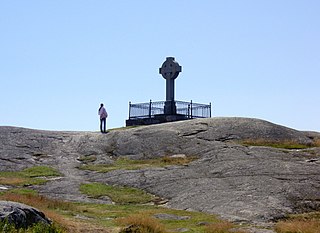
Birka, on the island of Björkö in present-day Sweden, was an important Viking Age trading center which handled goods from Scandinavia as well as many parts of the European continent and the Orient. Björkö is located in Lake Mälaren, 30 kilometers west of contemporary Stockholm, in the municipality of Ekerö.

A needlework sampler is a piece of embroidery or cross-stitching produced as a 'specimen of achievement', demonstration or a test of skill in needlework. It often includes the alphabet, figures, motifs, decorative borders and sometimes the name of the person who embroidered it and the date. The word sampler is derived from the Latin exemplum, which means 'example'.

Linen is a textile made from the fibers of the flax plant.

Sutton Hoo is the site of two Anglo-Saxon cemeteries dating from the 6th to 7th centuries near Woodbridge, Suffolk, England. Archaeologists have been excavating the area since 1938, when an undisturbed ship burial containing a wealth of Anglo-Saxon artefacts was discovered. The site is important in establishing the history of the Anglo-Saxon kingdom of East Anglia as well as illuminating the Anglo-Saxons during a period which lacks historical documentation.
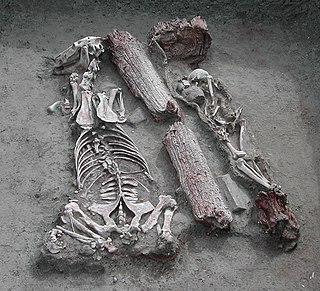
The Pazyrykburials are a number of Scythian (Saka) Iron Age tombs found in the Pazyryk Valley and the Ukok plateau in the Altai Mountains, Siberia, south of the modern city of Novosibirsk, Russia; the site is close to the borders with China, Kazakhstan and Mongolia.

A ship burial or boat grave is a burial in which a ship or boat is used either as the tomb for the dead and the grave goods, or as a part of the grave goods itself. If the ship is very small, it is called a boat grave. This style of burial was practiced by various seafaring cultures in Asia and Europe. Notable ship burial practices include those by the Germanic peoples, particularly by Viking Age Norsemen, as well as the pre-colonial ship burials described in the Boxer Codex in the Philippines.

A tumulus is a mound of earth and stones raised over a grave or graves. Tumuli are also known as barrows, burial mounds or kurgans, and may be found throughout much of the world. A cairn, which is a mound of stones built for various purposes, may also originally have been a tumulus.

The Oseberg ship is a well-preserved Viking ship discovered in a large burial mound at the Oseberg farm near Tønsberg in Vestfold county, Norway. This ship is commonly acknowledged to be among the finest artifacts to have survived from the Viking Age. The ship and some of its contents are displayed at the Viking Ship Museum at Bygdøy on the western side of Oslo, Norway.
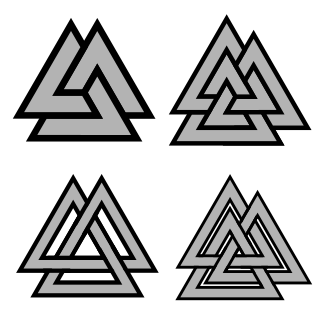
The valknut is a symbol consisting of three interlocked triangles. It appears on a variety of objects from the archaeological record of the ancient Germanic peoples. The term valknut is a modern development; it is not known what term or terms were used to refer to the symbol historically.
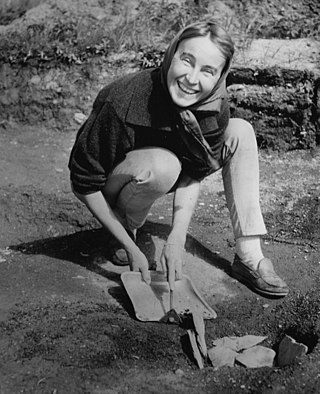
Anne Stine Ingstad was a Norwegian archaeologist who, along with her husband explorer Helge Ingstad, discovered the remains of a Norse settlement at L'Anse aux Meadows in the Canadian province of Newfoundland and Labrador in 1960.

Norse funerals, or the burial customs of Viking Age North Germanic Norsemen, are known both from archaeology and from historical accounts such as the Icelandic sagas and Old Norse poetry.

Viking art, also known commonly as Norse art, is a term widely accepted for the art of Scandinavian Norsemen and Viking settlements further afield—particularly in the British Isles and Iceland—during the Viking Age of the 8th-11th centuries. Viking art has many design elements in common with Celtic, Germanic, the later Romanesque and Eastern European art, sharing many influences with each of these traditions.

The Viking Ship Museum is located on the Bygdøy peninsula in Oslo, Norway. It will be temporarily closed from September 2021 until 2027.

The Ladby ship is a major ship burial at the village of Ladby near Kerteminde in Denmark. It is of the type also represented by the boat chamber grave of Hedeby and the ship burials of Oseberg, Borre, Gokstad and Tune in South Norway, all of which date back to the 9th and 10th centuries. It is the only ship burial from the Viking Age discovered in Denmark. It has been preserved at the site where it was discovered, which today is part of a museum.
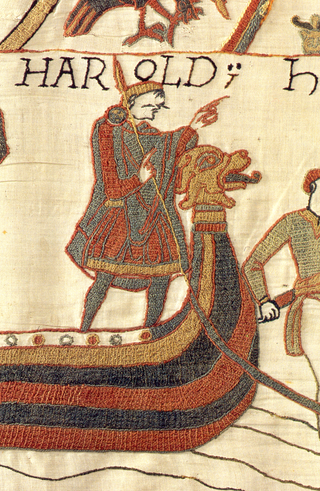
Anglo-Saxon dress refers to the clothing and accessories worn by the Anglo-Saxons from the middle of the second century to the eleventh century. Archaeological finds in Anglo-Saxon cemeteries have provided the best source of information on Anglo-Saxon costume. It is possible to reconstruct Anglo-Saxon dress using archaeological evidence combined with Anglo-Saxon and European art, writing and literature of the period. Archaeological finds have both supported and contradicted the characteristic Anglo-Saxon costume as illustrated and described by these contemporary sources.

The Sutton Hoo purse-lid is one of the major objects excavated from the Anglo-Saxon royal burial-ground at Sutton Hoo in Suffolk, England. The site contains a collection of burial mounds, of which much the most significant is the undisturbed ship burial in Mound 1 containing very rich grave goods including the purse-lid. The person buried in Mound 1 is usually thought to have been Rædwald, King of East Anglia, who died around 624. The purse-lid is considered to be "one of the most remarkable creations of the early medieval period." About seven and a half inches long, it is decorated with beautiful ornament in gold and garnet cloisonné enamel, and was undoubtedly a symbol of great wealth and status. In 2017 the purse-lid was on display at the British Museum.
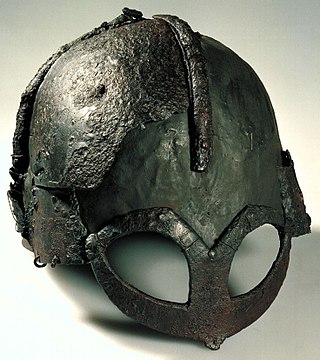
The Gjermundbu helmet is a Viking Age helmet.

The Gokstad Mound is a large burial mound at Gokstad Farm in Sandefjord in Vestfold County, Norway. It is also known as the King's Mound (Kongshaugen) and is where the 9th century Gokstad Ship was found.

Sagastad Viking Center is a knowledge center situated in Nordfjordeid in Western Norway. It is considered a landmark in the town, and is the most visited attraction in the area. The center is the home of the full-scale reconstruction of the largest Viking long ship ever discovered; the Myklebust ship.
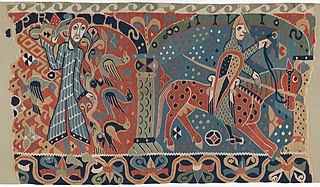
The Baldishol Tapestry is one of the oldest known surviving tapestries in Norway, and among the oldest in Europe. It is believed to have been produced between 1040 and 1190. It was discovered in Norway in 1879. It is part of the collection of the National Museum in Oslo. Tapestries of this type were popular in Norway from the Saga Age up until the 1600s.






















